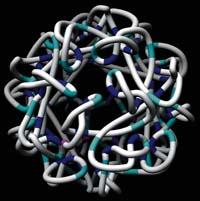Simulate a computer virus

The University of Illinois (USA) has performed a detailed simulation of a computer virus. What they have imagined has been a small RNA --satellite tabaque-mosaic virus -, with about a million atoms. Thanks to a computer program called NAMD, they have been able to analyze each of these atoms.
The NAMD program allows to simulate biological molecules with great success. The program launches hundreds of parallel computers to complete the calculations of a home computer for 35 years in an acceptable time. 50 billion images per femtosecond have been analyzed in a second of the virus life (10-15 seconds). The simulation reveals that although the virus is symmetrical, it has irregular pulses and a rare form of reproduction.
Larger simulations of viruses and more complex biological systems, as well as longer simulations, are expected in the future. But for this they will have to wait for the new generation of computers, which they hope will come in about five years.





